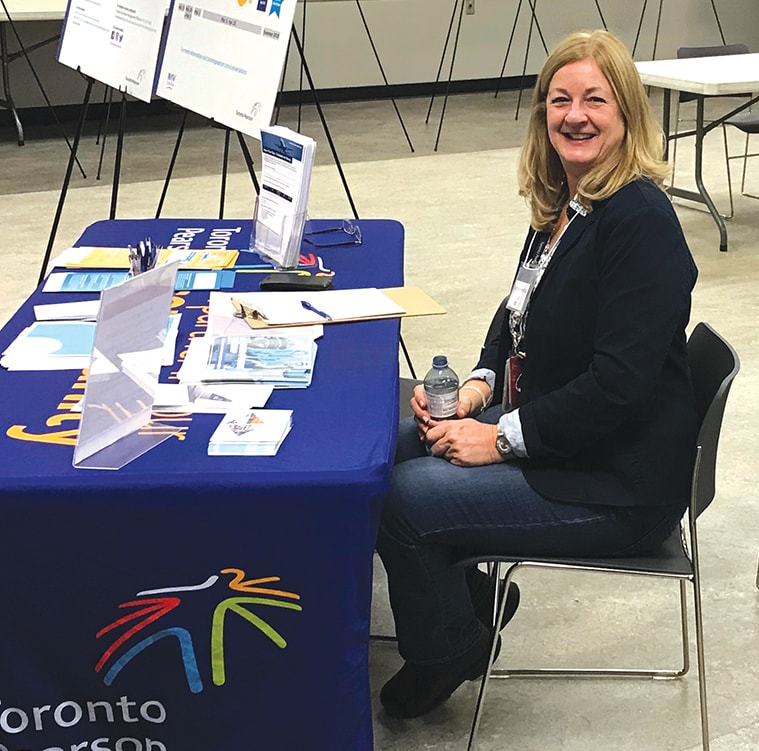As a top-tier airport connecting to the global economy, we’re helping to create jobs, attract investment and drive growth. But positive impacts can also raise concerns. So we engage with our communities to hear their views and talk about how we can balance priorities to yield the best possible benefits – for everyone.
Managing Noise
One of the realities of a conveniently located airport is that nearby communities experience a certain amount of aircraft noise. Much can be done to minimize the impact, from improving aircraft technology to carefully managing flight patterns and procedures. Toronto Pearson has been a leader in this area, working with air carriers and our other operations partners to mitigate both the level and frequency of airport-related noise. We also invite residents of nearby communities to ask questions and express concerns at regular public meetings of the Community Environment and Noise Advisory Committee (CENAC).
Toronto Pearson has a comprehensive noise management program to help offset and reduce the impacts from routine operations. We formally review the program every five years and produce a new action plan mapping out how our noise management activities will continue to evolve. In December 2017, following two years of consultations with aviation experts and extensive engagement with our neighbouring communities, we released the latest of these strategy documents, Growing Responsibly: 2018–2022 Noise Management Action Plan.
The plan outlines 10 commitments and the concrete actions we’ll take to fulfill them:

Working closely with NAV Canada, Transport Canada, our airline partners and other stakeholders, we’ll look for further ways to reduce noise while ensuring that community residents have a clear understanding of our respective roles, responsibilities and accountabilities.

We’ll identify new ways for our neighbours to provide input, encouraging wider community involvement as we address noise challenges together. This includes reviewing the goals, membership and governance of CENAC to ensure it meets residents’ needs and expectations.

We’re exploring programs to fund noise insulation in some residents’ homes, as well as air conditioning systems in area schools. We’ll also work with municipalities on stricter zoning requirements, and with realtors to promote better understanding of noise impacts.

We’re exploring changes to Toronto Pearson’s Night Flight Restriction Program to reflect global best practices. A review of our nighttime Preferential Runway Program will ensure aircraft are flying over as few people as possible. And we’re revisiting night landing fees.

Our new Quieter Fleet Incentive Program, which encourages airlines to bring their quietest aircraft to Toronto Pearson, will be in place by 2019. We’ll also be reporting on individual airlines’ noise performance. And we’re working with NAV Canada to identify flight paths that will reduce noise over some communities.

Toronto Pearson will be a noise research leader. We’ll improve our complaint process to allow deeper analysis of individual concerns and will publish a quarterly trends analysis. We’ll also report on data from our 25 Noise Monitoring Terminals, identifying issues and suggesting opportunities to mitigate and manage them.

Our airport is a dynamic environment, and sometimes we need to do unexpected work or alter runway operations. We want our neighbours to be fully informed about what we’re doing and how it may affect them. Plans include a new noise management website and a multi-channel construction communications protocol.

Toronto Pearson’s environmental team focuses on climate change, resource management and sustaining a healthy planet. Supported by a best-in-class environmental management system, we’ll continue working to mitigate our impacts, ensure regulatory compliance and be a responsible neighbour.

The GTAA will continue to support regional growth, including working with all levels of government to advance the proposed regional transit centre at Toronto Pearson. And we’ll deepen our commitment to boosting economic vitality through our community investment program, the Propeller Project.

We’ll continue to connect regularly with our neighbours so we can better understand their concerns and discuss our operational decisions and constraints. We’ll provide an annual update on the Noise Management Action Plan. And at the end of five years, we’ll review our progress and identify new initiatives for the next plan.

Runway Construction Ahead
We routinely close Toronto Pearson’s runways for brief periods – during snow removal and anti-icing, for instance, or to make minor repairs. In late March 2017, we began a larger-scale project: the rehabilitation of Runway 05/23, our airport’s busiest. The round-the-clock job entailed extensive renovation and repaving. Crews also reconditioned 1,000 lights and repainted 420 kilometres of markings.
This complex engineering project was completed on time in mid-May, ahead of the busy summer season. We even managed to include an extra construction phase originally slated for fall. However, the project did have a significant impact on flight schedules, in some cases disrupting people’s travel plans. Moreover, when flights that normally use the east/west runway were shifted to north/south alternatives, some nearby neighbourhoods experienced unfamiliar levels of air traffic.
We undertook this infrastructure project to ensure Toronto Pearson continues operating safely. However, in hindsight we recognize that we could have done a better job of informing the public about the work and its potential impact. We’ve therefore developed a new construction communications protocol.
As this annual report is being finalized, we’re about to begin resurfacing another busy runway, 06L/24R. The work will be far less disruptive, as it’s being conducted at night. Just as importantly, 90 days ahead of the start date, we launched an intensive communications campaign that includes web updates, e-newsletters, social media, press releases, newspaper ads, robocalls, messaging for passenger service staff and briefings for elected officials and the media. We’ve brought the spirit of continuous improvement that drives all of our operations to rethinking how we can best keep our neighbours engaged and informed.
2,500+ community members completed our 2017 Survey on Airport Growth and Noise Fairness, which was sent to 20,000 randomly selected homes across the GTA and was also available online for any resident to complete.

Listening to Residents
One of the foundational pieces of our 2018–2022 Noise Management Action Plan for Toronto Pearson was the final report of the Residents’ Reference Panel on Airport Growth and Noise Fairness.
After gathering input from more than 2,500 GTA residents through our 2017 Survey on Airport Growth and Noise Fairness, we undertook a unique effort to hear from a cross-section of residents living throughout the region. A 36-person Residents’ Reference Panel was assembled to advise us on the measures, standards and commitments we should adopt to meet community needs and support regional growth. Panellists were randomly selected through a civic lottery, although communities closest to the airport were given the greatest representation.
“It was an eye-opening learning experience. I liked being able to share my opinion and have it appreciated. All opinions were needed, and it was okay to disagree. Most of my position centred around more transit and making better links between Toronto Pearson and the other airports.”

Over the course of four Saturdays, the Residents’ Reference Panel heard from more than 20 experts and guests, including local community groups. They used what they learned, along with the findings of the noise-fairness survey and their own experiences, to develop recommendations for our consideration. The overarching sentiment was that Toronto Pearson needs to raise its game and act as a leader in noise management as we continue to support growing demand for air travel in the region.
Among the panel’s recommendations:
- Provide incentives for airlines to retrofit current aircraft or switch to quieter planes.
- Adopt more night flight restrictions, including a new formula for managing such flights.
- Explore other options to mitigate noise, such as a home insulation program for affected households. A noise sharing program should only be pursued if the respite it provides to communities is meaningful and predictable.
- Improve coordination between the GTAA, NAV Canada, Transport Canada and airlines.
The panel’s final report and the results of the Survey on Airport Growth and Noise Fairness are posted on our website.
Who Does What in Noise Management
The GTAA develops and manages the Noise Management Program at Toronto Pearson and explores new opportunities for noise mitigation.
NAV Canada is the air navigation provider responsible for safe and efficient movement of aircraft in Canada and for assigning runways at Toronto Pearson. We’re partnering with NAV Canada on various projects, including the Noise Mitigation Initiatives Engagement Plan, which looks at six big ideas for reducing noise impact.
Transport Canada is the regulator for aviation in Canada, with responsibility for enforcing compliance with noise standards and restrictions.
Air carriers are responsible for conducting operations in accordance with Transport Canada regulations and Toronto Pearson’s Noise Abatement Procedures and Noise Operating Restrictions.
The Community Environment and Noise Advisory Committee (CENAC) – sponsored by the GTAA and comprising residents and elected representatives from local municipalities – is an ongoing forum for discussing and asking questions about noise and other environmental issues. See Stakeholder Engagement to learn about CENAC’s 2017 discussions.

Learn more about how we help our communities prosper and grow
Job creation. Better transit connections. Building stronger communities. And listening closely to our stakeholders as we balance competing priorities. It all comes down to getting everyone moving better.
